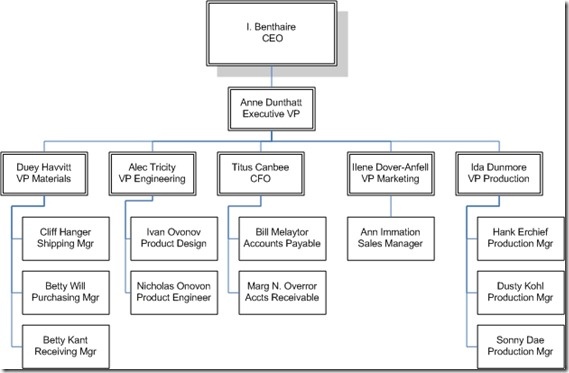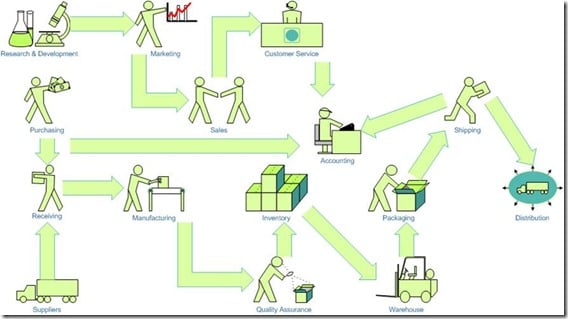NOTE: If you want to reap the most from this series, we recommend that you go back to start with Part 1.
In Part 1 of this series, we said that the biggest problem with “brainstorming” as it is frequently practiced is the context in which it is applied. Next, we introduce the concept of “system thinking”—stepping away from the traditional “functional view,” where management sees only a collection of departments and operations, to look at your enterprise from 40,000 feet in order to grasp the “flow” that leads to the production of Throughput.
Here are two illustrations covering the “functional” (i.e., department or silo) view versus the process “flow” view of an enterprise:
HOW MANAGEMENT VIEWS THE ORGANIZATION
HOW THE ENTERPRISE ACTUALLY WORKS
Traditional management methods and “brainstorming” attempts are generally aimed at local improvement—improvement in one function or silo—falsely believing that improvement in one part of the organization will improve the organization as a whole. This approach only haphazardly produces desired results—only when management (usually somewhat by accident) stumbles upon the system’s constraint.
THEORY OF CONSTRAINTS’ FIVE FOCUSING STEPS
The difference between traditional management’s attempts at improvement and implementations of “brainstorming” for solutions and the Thinking Processes that emerged from Eliyahu Goldratt’s Theory of Constraints is around the fundament concept of focus.
Goldratt contends that any process of ongoing improvement (POOGI) must consider the entire system (not individual portions or functions within the system), the system’s goal, and the reality that every system must have at least one constraint or bottleneck. (Of course, we know this last point must be true. Otherwise, in a system where the goal is profit, in the absence of at least one constraint, the system would become infinitely profitable.)
By taking these assumptions as its base, Goldratt’s Theory of Constraints next lays out what are called The Five Focusing Steps:
- Identify the system’s constraint(s)
- Decide how to exploit the system’s constraint(s)
- Subordinate everything else to the constraint(s) and decisions made in steps 1 and 2 above
- Elevate the system’s constraint(s)
- Return to step 1 and do not allow inertia to become the system’s constraint
IDENTIFYING THE SYSTEM’S CONSTRAINT(S)
Goldratt recognized that management, in many cases, was entirely unfamiliar with their own organization’s as “systems.” They only saw their enterprise as a group of connected departments, divisions and functions. They did not grasp the reality of interplay and dependencies between decisions and actions taken in one department and the affects of those decisions and actions as they played out in some other functions or departments. They had no grasp of the true cause-and-effect relationships at work across their enterprise.
Of course, these cause-and-effect relationships are not easily decipherable from ERP data. In fact, some cause-and-effect relationships don’t even leave an imprint on the ERP data (other than lower profits, for example).
What is needed to identify these hidden cause-and-effect relationships in the enterprise process flows is the ability to unlock “tribal knowledge.”
As Toyota’s management discovered long ago, “No one know more about the machine than the man who runs it.”
In other words, executives and managers have lots of knowledge about how things should work and, perhaps, about how the processes and procedures are designed to work. But only the people who work in and with those processes and procedure day-in and day-out know how they actually work. This information is not encoded in writing or electronically anywhere. This is all “tribal knowledge”—knowledge in the heads and hearts of the workers within the “system.” This knowledge must be unlocked and Goldratt’s Thinking Processes provide a way to both unlock and document this “tribal knowledge.”
We will talk about how that gets done in our next segment. Stay tuned!





